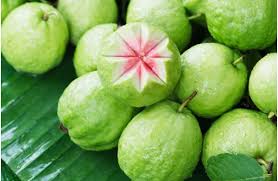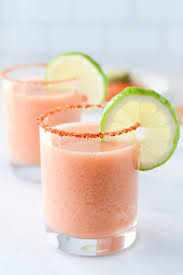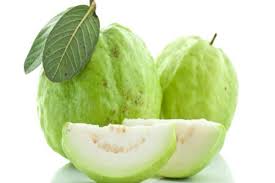One of the most gregarious of fruit trees, the guava, Psidium guajava L., of the myrtle family (Myrtaceae), is almost universally known by its common English name or its equivalent in other languages. In Spanish, the tree is guayabo, or guayavo, the fruit guayaba or guyava. The French call it goyave or goyavier; the Dutch, guyaba, goeajaaba; the Surinamese, guave or goejaba; and the Portuguese, goiaba or goaibeira. Hawaiianscall it guava or kuawa. In Guam it is abas. In Malaya, it is generally known either as guava or jambu batu, but has also numerous dialectal names as it does in India, tropical Africa and the Philippines where the corruption, bayabas, is often applied. Various tribal names–pichi, posh, enandi, etc.–are employed among the Indians of Mexico and Central and South America.

Description
A small tree to 33 ft (10 in) high, with spreading branches, the guava is easy to recognize because of its smooth, thin, copper-colored bark that flakes off, showing the greenish layer beneath; and also because of the attractive, “bony” aspect of its trunk which may in time attain a diameter of 10 in (25 cm). Yelliptic, somewhat irregular in outline; 2 3/4 to 6 in (7-15 cm) long, I ‘A to 2 in (3-5 cm) wide, leathery, with conspicuous parallel veins, and more or less downy on the underside. Faintly fragrant, the white flowers, borne singly or in small clusters in the leaf axils, are 1 in (2.5 cm) wide, with 4 or 5 white petals which are quickly shed, and a prominent tuft of perhaps 250 white stamens tipped with pale-yellow anthers.
The fruit, exuding a strong, sweet, musky odor when ripe, may be round, ovoid, or pear-shaped, 2 to 4 in (5-10 cm) long, with 4 or 5 protruding floral remnants (sepals) at the apex; and thin, light-yellow skin, frequently blushed with pink. Next to the skin is a layer of somewhat granular flesh, 1/8 to 1/2 in (3-12.5 mm) thick, white, yellowish, light- or dark-pink, or near-red, juicy, acid, subacid, or sweet and flavorful. The central pulp, concolorous or slightly darker in tone, is juicy and normally filled with very hard, yellowish seeds, 1/8 in (3 min) long, though some rare types have soft, chewable seeds. Actual seed counts have ranged from 112 to 535 but some guavas are seedless or nearly so.
Food Uses
Raw guavas are eaten out-of-hand, but are preferred seeded and served sliced as dessert or in salads. More commonly, the fruit is cooked and cooking eliminates the strong odor. A standard dessert throughout Latin America and the Spanish-speaking islands of the West Indies is stewed guava shells, that is, guava halves with the central seed pulp removed, strained and added to the shells while cooking to enrich the sirup. The canned product is widely sold and the shells can also be quick-frozen. They are often served with cream cheese. Sometimes guavas are canned whole or cut in half without seed removal.

Bars of thick, rich guava paste and guava cheese are staple sweets, and guava jelly is almost universally marketed. Guava juice, made by boiling sliced, unseeded guavas and straining, is much used in Hawaii in punch and ice cream sodas. A clear guava juice with all the ascorbic acid and other properties undamaged by excessive heat, is made in South Africa by trimming and mincing guavas, mixing with a natural fungal enzyme (now available under various trade names), letting stand for 18 hours at 120º to 130º F (49º-54º C) and filtering. It is made into sirup for use on waffles, ice cream, puddings and in milkshakes. After washing and trimming of the floral remnants, whole guavas in sirup or merely sprinkled with sugar can be put into plastic bags and quick-frozen.
There are innumerable recipes for utilizing guavas in pies, cakes, puddings, sauce, ice cream, jam, butter, marmalade, chutney, relish, catsup, and other products. In India, discoloration in canned guavas has been overcome by adding 0.06% citric acid and 0.125% ascorbic acid to the sirup. For pink sherbet, French researchers recommend 2 parts of the cultivar ‘Acid Speer’ and 6 parts ‘Stone’. For white or pale-yellow sherbet, 2 parts ‘Supreme’ and 4 parts ‘Large White’. In South Africa, a baby-food manufacturer markets a guava-tapioca product, and a guava extract prepared from small and overripe fruits is used as an ascorbic-acid enrichment for soft drinks and various foods.
Dehydrated guavas may be reduced to a powder which can be used to flavor ice cream, confections and fruit juices, or boiled with sugar to make jelly, or utilized as pectin to make jelly of low-pectin fruits. India finds it practical to dehydrate guavas during the seasonal glut for jelly-manufacture in the off-season. In 1947, Hawaii began sea shipment of frozen guava juice and puree in 5-gallon cans to processors on the mainland of the United States. Since 1975, Brazil has been exporting large quantities of guava paste, concentrated guava pulp, and guava shells not only to the United States but to Europe, the Middle East, Africa and Japan.
Canned, frozen guava nectar is an important product in Hawaii and Puerto Rico but may be excessively gritty unless stone cells from the outer flesh and skin are reduced by use of a stone mill or removed by centrifuging.
In South Africa, guavas are mixed with cornmeal and other ingredients to make breakfast-food flakes.
Green mature guavas can be utilized as a source of pectin, yielding somewhat more and higher quality pectin than ripe fruits.
| Guava Value Per 100 g of Edible Portion* | |
| Calories | 36-50 |
| Moisture | 77-86 g |
| Crude Fiber | 2.8-5.5 g |
| Protein | 0.9-1.0 g |
| Fat | 0.1-0.5 g |
| Ash | 0.43-0.7 g |
| Carbohydrates | 9.5-10 g |
| Calcium | 9.1-17 mg |
| Phosphorus | 17.8-30 mg |
| Iron | 0.30-0.70 mg |
| Carotene (Vitamin A) | 200-400 I.U. |
| Thiamine | 0.046 mg |
| Riboflavin | 0.03-0.04 mg |
| Niacin | 0.6-1.068 mg |
| Vitamin B3 | 40 I.U. |
| Vitamin G4 | 35 I.U. |
*Analyses of whole ripe guavas.
Ascorbic acid–mainly in the skin, secondly in the firm flesh, and little in the central pulp–varies from 56 to 600 mg. It may range up to 350-450 mg in nearly ripe fruit. When specimens of the same lot of fruits are fully ripe and soft, it may decline to 50-100 mg. Canning or other heat processing destroys about 50% of the ascorbic acid. Guava powder containing 2,500-3,000 mg ascorbic acid was commonly added to military rations in World War II. Guava seeds contain 14% of an aromatic oil, 15% protein and 13% starch. The strong odor of the fruit is attributed to carbonyl compounds.
Other Uses
Wood: The wood is yellow to reddish, fine-grained, compact, moderately strong, weighs 650-750 kg per cubic meter; is durable indoors; used in carpentry and turnery. Though it may warp on seasoning, it is much in demand in Malaya for handles; in India, it is valued for engravings. Guatemalans use guava wood to make spinning tops, and in El Salvador it is fashioned into hair combs which are perishable when wet. It is good fuelwood. and also a source of charcoal.
Leaves and bark: The leaves and bark are rich in tannin (10% in the leaves on a dry weight basis, 11-30% in the bark). The bark is used in Central America for tanning hides. Malayans use the leaves with other plant materials to make a black dye for silk. In southeast Asia, the leaves are employed to give a black color to cotton; and in Indonesia, they serve to dye matting.

Wood flowers: In Mexico, the tree may be parasitized by the mistletoe, Psittacanthus calyculatus Don, producing the rosette-like malformations called “wood flowers” which are sold as ornamental curiosities.
Medicinal Uses: The roots, bark, leaves and immature fruits, because of their astringency, are commonly employed to halt gastroenteritis, diarrhea and dysentery, throughout the tropics. Crushed leaves are applied on wounds, ulcers and rheumatic places, and leaves are chewed to relieve toothache. The leaf decoction is taken as a remedy for coughs, throat and chest ailments, gargled to relieve oral ulcers and inflamed gums; and also taken as an emmenagogue and vermifuge, and treatment for leucorrhea. It has been effective in halting vomiting and diarrhea in cholera patients. It is also applied on skin diseases. A decoction of the new shoots is taken as a febrifuge. The leaf infusion is prescribed in India in cerebral ailments, nephritis and cachexia. An extract is given in epilepsy and chorea and a tincture is rubbed on the spine of children in convulsions. A combined decoction of leaves and bark is given to expel the placenta after childbirth.
The leaves, in addition to tannin, possess essential oil containing the sesquiterpene hydrocarbons caryophyllene, b-bisabolene, aromadendrene, b-selinene, nerolidiol, caryophyllene oxide and sel-11-en-4x -ol, also some triterpenoids and b-sitosterol. The bark contains tannin, crystals of calcium oxalate, ellagic acid and starch. The young fruits are rich in tannin.
Guavas are also rich in manganese which helps the body to absorb other key nutrients from the food that we eat. Guavas benefits are credited due to the presence of folate, a mineral which helps promote fertility. The potassium in guavas helps normalise blood pressure levels as well. In fact, a banana and a guava contain almost the same amount of potassium. Since it contains about
Guava Nutritional Value
Benefits of guavas are aplenty and now we’re going to talk about guava’s nutritional value. A 100 gm serving of the fruit contains just 68 calories and 8.92 gm sugar, according to the data of United States Department of Agriculture (USDA). Guavas are also rich in calcium as they contain 18 gm of the mineral per 100 gm of the fruit. It also contains 22 gm of magnesium per 100 gm of the fruit, as well as significant amounts of phosphorus and potassium- 40 and 417 gm per 100 gm, respectively.
Health Highlights
- Guava is one of the richest sources of dietary fiber.
- Besides immunity, guava do wonders to skin and also promotes fertility.
- Guava also helps in regulating metabolism which leads to weight loss.
Have not all of us enjoyed a plateful of guavas sprinkled with chaat masala atop? Nothing else can match up to the luscious jams, jellies and murabbas laced withan intoxicating strong-sweet fragrance. It is believed to have its genesis in Central America where it is alternatively known as “sand plum”. It is round or oval in shape with light green or light yellow skin, and the colour of its flesh varies from white or pink to dark red and has edible seeds. It indeed is a powerhouse of nutrients. “This humble fruit is extraordinarily rich in vitamin C, lycopene and antioxidants that are beneficial for skin. Guavas are also rich in manganese which helps the body to absorb other key nutrients from the food that we eat. Guavas benefits are credited due to the presence of folate, a mineral which helps promote fertility. The potassium in guavas helps normalise blood pressure levels as well. In fact, a banana and a guava contain almost the same amount of potassium. Since it contains about 80% of water it helps keep your skin hydrated”, says.
Guava Nutritional Value
Benefits of guavas are aplenty and now we’re going to talk about guava’s nutritional value. A 100 gm serving of the fruit contains just 68 calories and 8.92 gm sugar, according to the data of United States Department of Agriculture (USDA). Guavas are also rich in calcium as they contain 18 gm of the mineral per 100 gm of the fruit. It also contains 22 gm of magnesium per 100 gm of the fruit, as well as significant amounts of phosphorus and potassium- 40 and 417 gm per 100 gm, respectively.

Guava benefits for health and skin
Benefit of Guava for skin

- Immunity Booster
Did you know: Guavas are one of the richest sources of vitamin C? It’s true. Guava fruit contains 4 times the vitamin C content present in Oranges. Vitamin C helps improve immunity and protects you against common infections and pathogens. Moreover, it keeps your eyes healthy. - Lowers Risk of Cancer
“Lycopene, quercetin, vitamin C and other polyphenols act as potent antioxidants which neutralise free radicals generated in the body, preventing the growth of cancer cells. Guava fruit has shown to be widely successful in reducing prostate cancer risk and also inhibit the growth of breast cancer cells since it is rich in lycopene”, says. - Diabetes-Friendly
Due to the rich fibre content and low glycaemic index, guavas prevent the development of diabetes. While the low glycemic index inhibits a sudden spike in sugar levels, the fibre content ensures the sugar levels are well regulated. - Heart Healthy Guava fruit helps improve the sodium and potassium balance of the body, thereby regulating blood pressure in patients with hypertension. Guavas also help lower the levels of triglycerides and bad cholesterol (LDL), which contribute to the development of heart disease. This magical fruit improves levels of good cholesterol (HDL).
- Treats Constipation It is one of the richest sources of dietary fibre in comparison to other fruits and just 1 guava fulfills about 12% of your daily recommended intake of fibre, which makes it extremely beneficial for your digestive health. Guava seeds, if ingested whole or chewed, serve as excellent laxatives too, helping the formation of healthy bowel movements.
- Improves Eyesight
Due to the presence of Vitamin A, guava is well known as a booster for vision health. - Guava During Pregnancy Guava benefits pregnant women too as it contains folic acid, or vitamin B-9, which is recommended for pregnant women since it can help in developing the baby’s nervous system and protect the newborn from neurological disorders.
- Beats Toothache Guava leaves have a potent anti-inflammatory action and a powerful antibacterial ability which fights infection and kills germs. Thus, consuming guava leaves works as a fantastic home remedy for toothache. The juice of guava leaves has also been known to cure toothaches, swollen gums and oral ulcers.
- Stress-Buster The magnesium present in the fruit is responsible for one of the many benefits of guava, helps to relax the muscles and nerves of the body. So after a hard workout or a long day at the office, a guava is certainly what you need to relax your muscles, combat stress and give your system a good energy boost.
- Good for your Brain “Guavas contain vitamin B3 and vitamin B6, also known as niacin and pyridoxine respectively, which help in improving blood circulation to the brain, stimulating cognitive function and relaxing the nerves”.
- Weight Loss Want to shed a few pounds? Guava is just the ticket. Without compromising your intake of proteins, vitamins and fibre, guava helps you lose weight by regulating your metabolism. It’s a win-win! Guava makes for a very filling snack and satisfies the appetite very easily. Guava, especially raw guava, also has far less sugar as compared to apples, oranges, grapes, and other fruits.
- Cough and Cold Guava have one of the highest quantities of vitamin-C and iron among fruits, and both are proven to be preventive against cold and viral infections. The juice of raw and immature guavas or a decoction of guava-leaves is very helpful in relieving cough and cold since it helps get rid of mucus and disinfects the respiratory tract, throat and lungs.
- Anti-Ageing Properties Guavas are rich in vitamin A, vitamin C and antioxidants like carotene and lycopene which help protect the skin from wrinkles. A guava a day, keeps fine lines away!
- Improves Complexion Guava helps regain the skin’s radiance and freshness. Reap the benefits by preparing a DIY scrub at home: All you have to do is mash some guava flesh with an egg yolk and apply it on your face. Rinse off after 20 minutes with warm water. When used once or twice a week, this scrub will remove dead cells from your skin and lighten your complexion. Guavas are also a great source of Vitamin K, which helps get rid of skin discoloration, dark circles, redness and acne irritation.
- Improves Texture Guavas rank high in astringent properties, guava leaves and unripe guavas even higher. Guava helps tone up and tighten the facial muscles, so apply a decoction of the leaves and fruit on your skin and voila! our facebook page visit Related post
